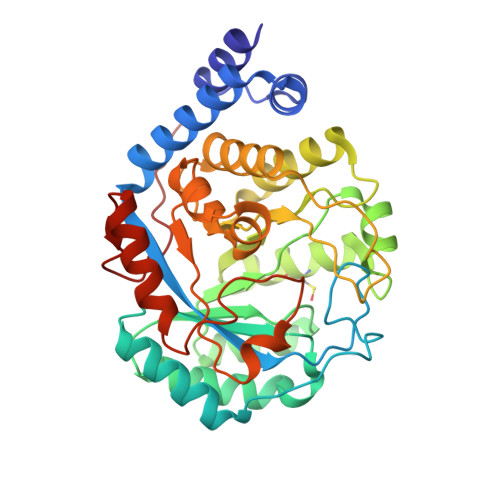X-ray snapshots of possible intermediates in the time course of synthesis and degradation of protein-bound Fe4S4 clusters.
Nicolet, Y., Rohac, R., Martin, L., Fontecilla-Camps, J.C.(2013) Proc Natl Acad Sci U S A 110: 7188-7192
- PubMed: 23596207
- DOI: https://doi.org/10.1073/pnas.1302388110
- Primary Citation of Related Structures:
4JXC, 4JY8, 4JY9, 4JYD, 4JYE, 4JYF - PubMed Abstract:
Fe4S4 clusters are very common versatile prosthetic groups in proteins. Their redox property of being sensitive to O2-induced oxidative damage is, for instance, used by the cell to sense oxygen levels and switch between aerobic and anaerobic metabolisms, as exemplified by the fumarate, nitrate reduction regulator (FNR). Using the hydrogenase maturase HydE from Thermotoga maritima as a template, we obtained several unusual forms of FeS clusters, some of which are associated with important structural changes. These structures represent intermediate states relevant to both FeS cluster assembly and degradation. We observe one Fe2S2 cluster bound by two cysteine persulfide residues. This observation lends structural support to a very recent Raman study, which reported that Fe4S4-to-Fe2S2 cluster conversion upon oxygen exposure in FNR resulted in concomitant production of cysteine persulfide as cluster ligands. Similar persulfide ligands have been observed in vitro for several other Fe4S4 cluster-containing proteins. We have also monitored FeS cluster conversion directly in our protein crystals. Our structures indicate that the Fe4S4-to-Fe2S2 change requires large structural modifications, which are most likely responsible for the dimer-monomer transition in FNR.
- Metalloproteins Unit, Institut de Biologie Structurale J.-P. Ebel, Commissariat à l'Energie Atomique-Centre National de la Recherche Scientifique-Université Grenoble-Alpes, 38027 Grenoble, France. yvain.nicolet@ibs.fr
Organizational Affiliation:


























